汉译英第二讲(句子翻译技巧)学生版
- 格式:docx
- 大小:23.29 KB
- 文档页数:5
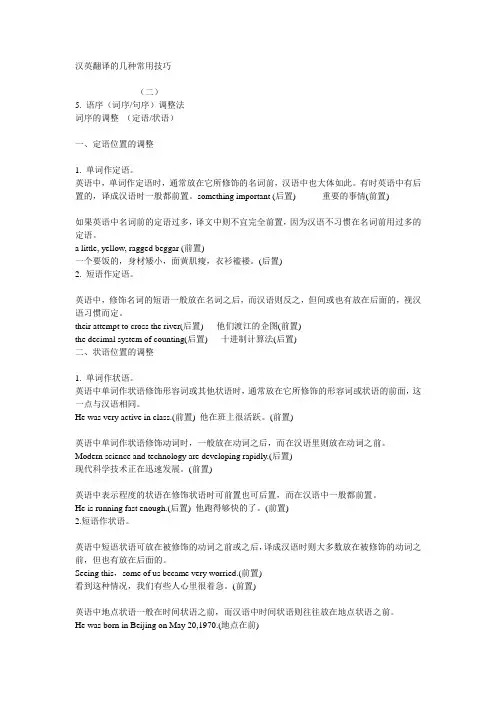
汉英翻译的几种常用技巧(二)5. 语序(词序/句序)调整法词序的调整(定语/状语)一、定语位置的调整1. 单词作定语。
英语中,单词作定语时,通常放在它所修饰的名词前,汉语中也大体如此。
有时英语中有后置的,译成汉语时一般都前置。
something important (后置) 重要的事情(前置)如果英语中名词前的定语过多,译文中则不宜完全前置,因为汉语不习惯在名词前用过多的定语。
a little, yellow, ragged beggar (前置)一个要饭的,身材矮小,面黄肌瘦,衣衫褴褛。
(后置)2. 短语作定语。
英语中,修饰名词的短语一般放在名词之后,而汉语则反之,但间或也有放在后面的,视汉语习惯而定。
their attempt to cross the river(后置) 他们渡江的企图(前置)the decimal system of counting(后置) 十进制计算法(后置)二、状语位置的调整1. 单词作状语。
英语中单词作状语修饰形容词或其他状语时,通常放在它所修饰的形容词或状语的前面,这一点与汉语相同。
He was very active in class.(前置) 他在班上很活跃。
(前置)英语中单词作状语修饰动词时,一般放在动词之后,而在汉语里则放在动词之前。
Modern science and technology are developing rapidly.(后置)现代科学技术正在迅速发展。
(前置)英语中表示程度的状语在修饰状语时可前置也可后置,而在汉语中一般都前置。
He is running fast enough.(后置) 他跑得够快的了。
(前置)2.短语作状语。
英语中短语状语可放在被修饰的动词之前或之后,译成汉语时则大多数放在被修饰的动词之前,但也有放在后面的。
Seeing this,some of us became very worried.(前置)看到这种情况,我们有些人心里很着急。
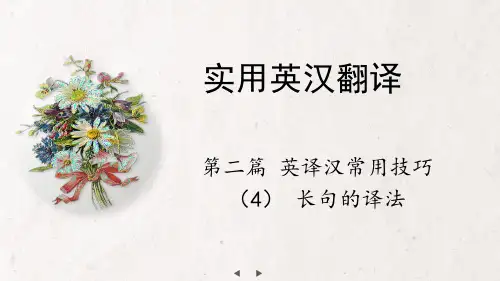
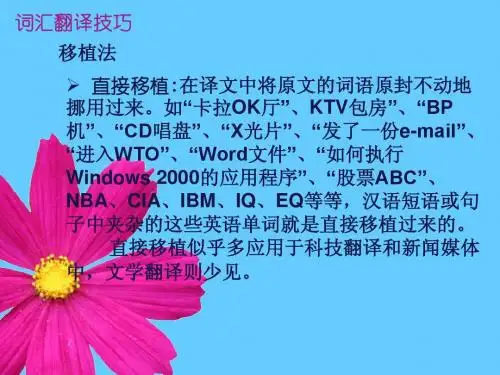
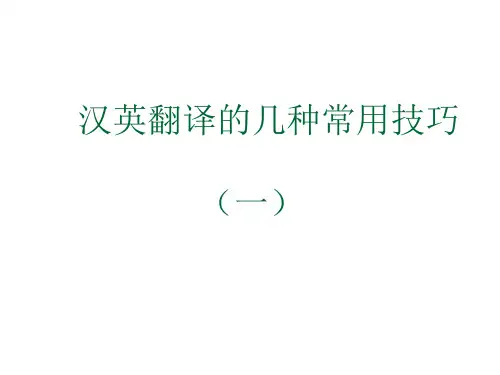
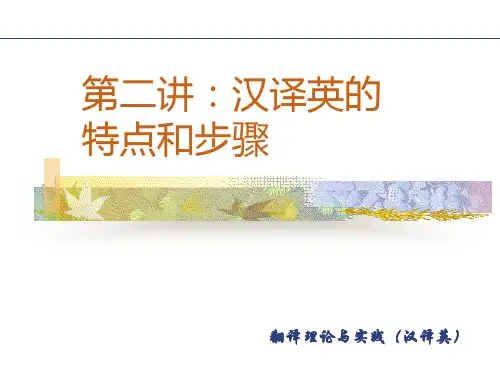

汉译英方法二——句法翻译一.无主句的译法无主句。
(一)英语用被动语态1.表示事物存在或出现的无主句。
1)这儿将修建更多的居民楼。
More apartments will be built here.2)去年发现了一种稀有元素。
A rare element was found last year.2.表示要求、规定的无主句。
3)发现了错误,一定要改正。
Wrongs must be corrected when they are discovered.4)本剧场内禁止吸烟。
Smoking is prohibited in this theater.(二)用there be句型,或是it 做形式主语+be +to, it is + past participle +that….等结构1.你忘了一句古话了吗:学到老,活到老。
更何况你并不老。
(周而复《上海的早晨》)You’re forgetting the old saying: one is never too old to learn. In any case, you are not old at all.2.总之,有两点需要考虑。
In short, there are two aspects have to be considered.(三)用倒装语序1.在游廊的最左端,靠近一道门,却坐着一位将近三十岁的男子。
(矛盾《子夜》)Close by a door at the extreme left of the corridor sat a man of about thirty.(四)用祈使句。
汉语中表示请求、命令、号召、标语、口号等无主句,可以用祈使句。
1.中国共产党万岁!Long live the Chinese Communist Party.2.此处禁止停车No Parking(五)用适当的名词或代词补出主语1.没有受过恋爱洗礼的人生,不能算是真正的人生。
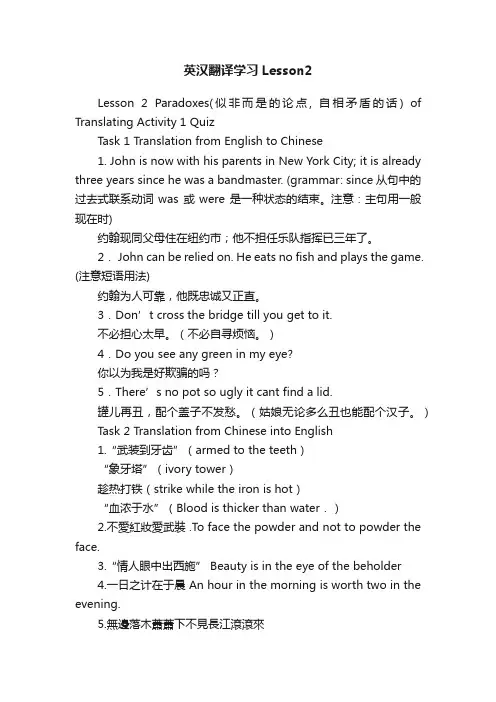
英汉翻译学习Lesson2Lesson 2 Paradoxes(似非而是的论点, 自相矛盾的话) of Translating Activity 1 QuizTask 1 Translation from English to Chinese1. John is now with his parents in New York City; it is already three years since he was a bandmaster. (grammar: since从句中的过去式联系动词was 或were 是一种状态的结束。
注意:主句用一般现在时)约翰现同父母住在纽约市;他不担任乐队指挥已三年了。
2. John can be relied on. He eats no fish and plays the game. (注意短语用法)约翰为人可靠,他既忠诚又正直。
3.Don’t cross the bridge till you get to it.不必担心太早。
(不必自寻烦恼。
)4.Do you see any green in my eye?你以为我是好欺骗的吗?5.There’s no pot so ugly it cant find a lid.罐儿再丑,配个盖子不发愁。
(姑娘无论多么丑也能配个汉子。
)Task 2 Translation from Chinese into English1.“武装到牙齿”(armed to the teeth)“象牙塔”(ivory tower)趁热打铁(strike while the iron is hot)“血浓于水”(Blood is thicker than water.)2.不愛紅妝愛武裝 .To face the powder and not to powder the face.3.“情人眼中出西施” Beauty is in the eye of the beholder4.一日之计在于晨 An hour in the morning is worth two in the evening.5.無邊落木蕭蕭下不見長江滾滾來The boundless forest sheds its leaves shower by showerThe endless rivers rolls its waves hour after hourActivity 2 Questions1. Could you write down the difficulties that you have come across when doing translation? (5mins)2. The following 4 questions are mainly based on Eugene A. Nida (1993). Please think over the questions below and write down your understandings.(1)Translating is a complex and fascinating task. In fact, some scholarshave claimed that it is probably the most complex type of event in the history of the cosmos(宇宙). And yet, translating is so natural and easy that children seem to have no difficulty in interpreting for their immigrant parents. These children normally do very well until they have gone to school and have learned about nouns, verbs, and adverbs. Why?Answer:Because they then try to match the words and grammar rather than the content.(2)Most people assume(vt.假定, 设想, 采取, 呈现) that literalness(n.文字的, 表面意义上的, 无修饰的) in translating means faithfulnessto the text. Because of the many discrepancies (n.相差, 差异, 矛盾)between meanings and structures of different languages, some people have insisted that translating is impossible. What do you think?Answer: Those who insist that translating is impossible are usually concerned with some of the more marginal(adj.记在页边的, 边缘的, 边际的) features of figurative (adj.比喻的, 修饰丰富的, 形容多的) language and complex poetic structures. The use offigurativelanguage is universal(adj.普遍的, 全体的, 通用的, 宇宙的, 世界的), but the precise figures of speech in one language rarely match those in another. Yet translating is simply doing the impossible well. In fact, though some famous authors insist that translating is impossible, they do not hesitate to have their own writingtranslated.(3)What do you think of the view that paraphrase(explanation) shouldbe avoided in translating?Answer: In fact, all translating involves different degrees of paraphrase, since there is no way in which one can successfully translate word for word and structure for structure. For example, the Chinese saying 他下海了is literally “He went down to the sea”, but is more appropriately translated as “He became a businessman”.Since languages do not differ essentially in what they can say, but in how they say it, paraphrase is inevitable. What is important is the semantic(语义的) legitimacy (n.合法(性), 正统(性), 正确(性), 合理(性)) of the paraphrase.(4)There is a widespread( adj.分布广泛的, 普遍的) view that atranslator should first produce a more or less literalrendering(translating) of the source text(source text源程序正文) and then proceed to improve it stylistically(adv.在文体上). Do you agree?Answer: Style is not the frosting on the cake(蛋糕上的糖霜), but an integral part(integral part主要的部分)of the text right from the beginning. It must bebuilt into the text right from the beginning. It is usually better to aim first at a stylistically satisfactory rendering of the source text and then review it carefully to “tighten it up” by analyzing and testing the correspondences(n.相应, 通信, 信件). A few errors in the correspondences of lexical meaning are much more excusable (adj.可原谅的, 可容许的, 言之有理的, 可免除的)than missing the spirit and aesthetic (adj.美学的, 审美的, 有审美感的)character of the source text.(Now how did you feel after going through the above 4 questions? You might feel a bit disappointed for there seems to be noth ing particularly exotic and exciting in Nida’s saying. At the same time, you might alsofeel a bit confused, for the above 4 questions do not present a very clear and well-organized picture of translation. Well, do not worry too much at this stage. In the rest of the book, we shall take a closer look at the nature and the procedures of translation. Our focus, however, will be on introducing some useful translation skills and on practicing translating ourselves. We shall also spend some time examining those language points on which English and Chinese differ, hence are difficult to deal with in translation. One such point is presented in Activity 3 below.) Activity 3 Language Differ: Differences in LexiconsSince translation theories and skills are both built upon the differences and similarities between the source language and the target language, in each chapter of this course, we shall examine one or two language points on which English and Chinese differ. First of all, Chinese and English show a lot of discrepancies in their lexicons, especially in word meanings and word combinations.Task 1 Words sharing the same designative(指定的)andassociative (adj. 联想的)meaningsSome English words and their Chinese counterparts share exactly the same designative and associative meanings. These are mainly some proper names, technical terms and the names of some everyday objects.Can you give their Chinese equivalents?The U.S. State Department 美国国务院Cognitive linguistics 认知语言学The Indian Ocean 印度洋AIDS 艾滋病Helicopter 直升飞机Skyscraper 摩天大楼Now please list 5 English examples and their Chinese counterparts and 5 Chinese examples and their English counterparts in the space provided below. Discuss with your partner if all the examples you list indeed share the same meanings and the same connotations(内涵)with their counterparts in the target language.List AList BTask 2 Words Not Sharing the Same MeaningsWhen you were thinking of your own examples for Task 1, you might already notice that many English words and their seeming (adj.表面上的)Chinese counterparts do not really share exactly the same meanings or connotations.(1) Is the following translation version provided the only possible one?If not, can you offer other versions?Brother哥弟Mother-in-law岳母婆婆Grandparents祖父母外祖父母Aunt姑姨、婶、Uncle叔伯、舅(2) Now can you think of your own English and Chinese examples? If yes, please write them down in the space provided below. You may have a brainstorming (自由讨论,智力爆发)with your partners if you happen to get stuck on your own.Task 3 English Words with More Than One MeaningAs learners of English, we are familiar with the fact that most English words have more than one meaning depending on different context. When translating into Chinese, these different meanings are usually matched with different Chinese words rather than with one Chinese word.A. To take “hard” as an example, can you translate the following phrases into Chinese?1.hard rocks 坚硬的岩石2.a hard blue 一种刺目(眼)的蓝色3.hard drugs 烈性毒品4.hard sounds 清音5.hard currency 硬通货6.hard water 水质较硬的水7.hard evidence 确凿的证据(铁证)8.a hard winter 一个严寒的冬天(严冬)9.hard times 艰难岁月10.hard on somebody 对某人很严厉11.a hard smile (一个)冷酷的微笑12.think hard 认真地思考13.hard work 辛苦的工作14.a hard question (一个)难回答的问题B. Loo k at the meanings of ‘man’1.man and his wife 丈夫和妻子2.officers and men 官和兵3.his man Friday 他的仆人礼拜五(丹尼尔·笛福《鲁滨逊漂流记》)4.man-of-war 军舰5.Be a man! 要像个男子汉﹗C. sophisticated1.sophisticated man 老于世故的人2.sophisticated woman 狡黠的女子3.sophisticated columnist 老练的专栏作家,资深专栏作家4.sophisticated electronic device 高度精密的电子装置5.sophisticated weapon 尖端武器D. run1.run to seed 花谢结子—不修边幅—丧失活力—破旧不堪2.run the streets 流浪街头3.run a hare 追捕野兔—追捕坐车不买票的人4.run one’s eyes down a list匆匆看一下单子5.run one’s head into a wall撞南墙;碰壁6.the machine runs well 机器运转良好7.the river runs east 河水流向东方(大江东流去)8.the news runs rapidly in the town 这个消息迅速在镇上传开Task 4 Chinese Words with More Than One Meaning You might already be saying to yourselves “Well, English is not alone in giving one word many different meanings. Chinese is even more extreme in this respec t.” You are certainly justified (v.证明...是正当的)in thinking that way.To take a very simple word下as an example. Can you translate the following into English?1.下班 get off work/ knock off2.下半辈子the later half of one’s life3.下策 an unwise decision/ a stupid move 4.下厨房 go to the kitchen (to prepare a meal) 5.下蛋 lay eggs6.下饭 go well with rice7.下岗 go off sentry(卫兵,岗哨) duty 8.下课 finish class/ the class is over 9.下列 listed below10.下坡路 a downhill path11.下棋 play chess12.下属 subordinate13.下乡 go to the countryside14.下旬 the last ten-day period of a month 15.下意识 sub-consciousnessTask 5 Co-occurrence with Other Words:Many English words and their Chinese counterparts also show a lot of differences in their combinations with other words. To take “play” as an example, to play basketball is 打篮球, to play football is踢足球 , and to play the piano is弹钢琴 .Now please try to translate the following sentences into Chinese, paying special attention to the italicized parts.1.He wore a pair of dark glasses and a thick grey overcoat.他戴一副墨镜,穿一件厚厚的灰外套。
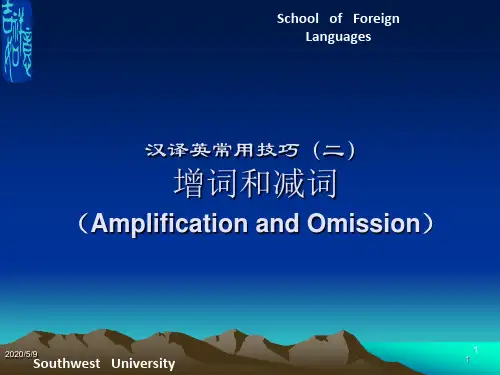
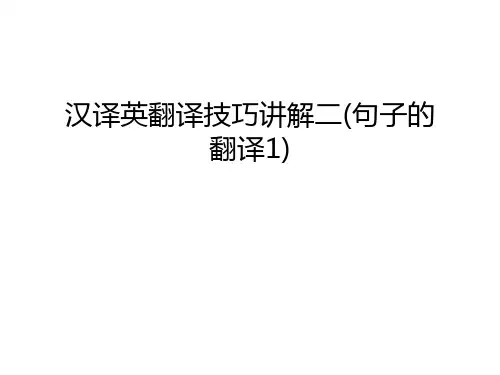
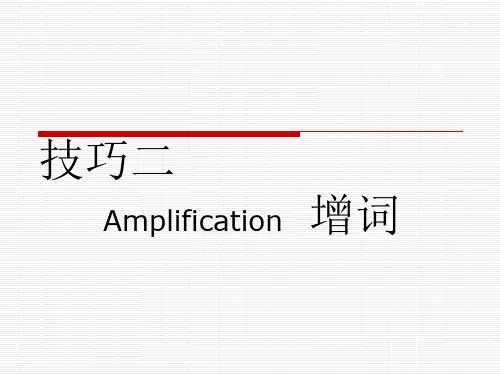
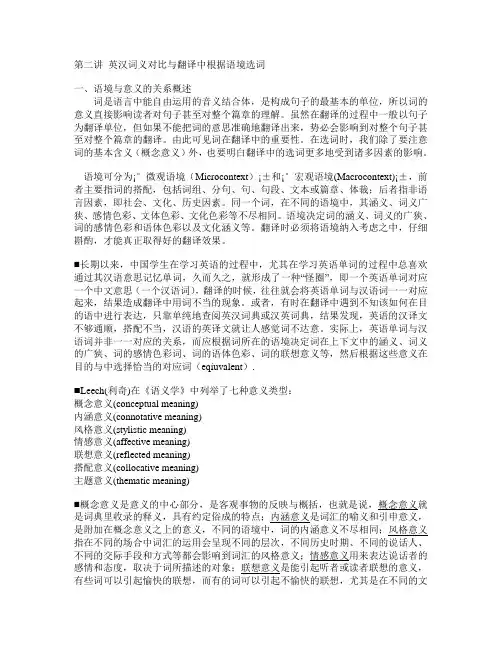
第二讲英汉词义对比与翻译中根据语境选词一、语境与意义的关系概述词是语言中能自由运用的音义结合体,是构成句子的最基本的单位,所以词的意义直接影响读者对句子甚至对整个篇章的理解。
虽然在翻译的过程中一般以句子为翻译单位,但如果不能把词的意思准确地翻译出来,势必会影响到对整个句子甚至对整个篇章的翻译。
由此可见词在翻译中的重要性。
在选词时,我们除了要注意词的基本含义(概念意义)外,也要明白翻译中的选词更多地受到诸多因素的影响。
语境可分为¡°微观语境(Microcontext)¡±和¡°宏观语境(Macrocontext)¡±,前者主要指词的搭配,包括词组、分句、句、句段、文本或篇章、体裁;后者指非语言因素,即社会、文化、历史因素。
同一个词,在不同的语境中,其涵义、词义广狭、感情色彩、文体色彩、文化色彩等不尽相同。
语境决定词的涵义、词义的广狭、词的感情色彩和语体色彩以及文化涵义等。
翻译时必须将语境纳入考虑之中,仔细斟酌,才能真正取得好的翻译效果。
⏹长期以来,中国学生在学习英语的过程中,尤其在学习英语单词的过程中总喜欢通过其汉语意思记忆单词,久而久之,就形成了一种“怪圈”,即一个英语单词对应一个中文意思(一个汉语词),翻译的时候,往往就会将英语单词与汉语词一一对应起来,结果造成翻译中用词不当的现象。
或者,有时在翻译中遇到不知该如何在目的语中进行表达,只靠单纯地查阅英汉词典或汉英词典,结果发现,英语的汉译文不够通顺,搭配不当,汉语的英译文就让人感觉词不达意。
实际上,英语单词与汉语词并非一一对应的关系,而应根据词所在的语境决定词在上下文中的涵义、词义的广狭、词的感情色彩词、词的语体色彩、词的联想意义等,然后根据这些意义在目的与中选择恰当的对应词(eqiuvalent).⏹Leech(利奇)在《语义学》中列举了七种意义类型:概念意义(conceptual meaning)内涵意义(connotative meaning)风格意义(stylistic meaning)情感意义(affective meaning)联想意义(reflected meaning)搭配意义(collocative meaning)主题意义(thematic meaning)⏹概念意义是意义的中心部分,是客观事物的反映与概括,也就是说,概念意义就是词典里收录的释义,具有约定俗成的特点;内涵意义是词汇的喻义和引申意义,是附加在概念意义之上的意义,不同的语境中,词的内涵意义不尽相同;风格意义指在不同的场合中词汇的运用会呈现不同的层次,不同历史时期、不同的说话人、不同的交际手段和方式等都会影响到词汇的风格意义;情感意义用来表达说话者的感情和态度,取决于词所描述的对象;联想意义是能引起听者或读者联想的意义,有些词可以引起愉快的联想,而有的词可以引起不愉快的联想,尤其是在不同的文化中,词的联想意义有很大的区别。
主语的选择①名词特性②搭配合理③主题突出④注意尾重⑤注意连贯①名词特性主语必须是名词,包括名词短语,名词性从句,也包括具有名词特性的-ing分词,动词不定式to do全球发展不平衡加剧。
Imbalance in global development has widened.求和平、谋发展、促和平已经成为各国人民的普遍愿望。
To promote peace, development and cooperation has become the shared aspiration of people across the world.建设生态文明,是关系人民福祉、民族未来的长远大计。
Promoting ecological progress is a long-term task of vital importance to the People’s well-being and China’s future. (to do 也可以)②搭配合理上海豫园的九曲桥,景随步移,美不胜收,旅游小册子中有这样一句话:每一次转折都会看到不同的景色。
Every turning can see/admire/enjoy a different view. ???转折做主语吗?中文是话题为主的,汉语看上去是主语,实际在英文中不过是时间,是地点或是状语。
唐朝出现了真正意义上的中国传统园林建筑。
园林出现了在唐朝。
Traditional Chinese architecture in a real sense first emerged/appeared in the Tang Dynasty.宋朝发明了活版印刷术。
③主题突出第四十一届世博会规模为历届之最。
The scale of the 41st World Expo is the biggest of its kind???The 41st World Expo is the biggest of its kind in scale.中国古典园林规模大小不等。
英汉翻译技巧第一部分英译汉CHAPTER ONE THE GENERAL INTRODUCTION OF TRANSLATIONTHE V ARIOUS DEFINITIONS OF TRANSLATION1)ALEXANDER FRASER TYTLER (1747-1814)I WOULD THEREFORE DESCRIBE A GOOD TRANSLATION TO BE: THAT, IN WHICH THE MERIT OF THE ORIGINAL WORK IS SO COMPLETELY TRANSFUSED INTO ANOTHER LANGUAGE, AS TO BE DISTINCTLY APPREHENDED, AND AS STRONGLY FELT, BY A NATIVE OF THE COUNTRY TO WHICH THAT LANGUAGE BELONGS, AS IT IS BY THOSE WHO SPEAK THE LANGUAGE OF THE ORIGINAL WORK.好的翻译应该是把原作的长处如此完备地移注入另一种语言,以使译入语所属国家的本地人能明白地领悟、强烈地感受,如同使用原作语言的人所领悟、所感受的一样。
THE THREE GENERAL RULES FOR TRANSLATION:FIRST GENERAL RULE: A TRANSLATION SHOULD GIVE A COMPLETE TRANSCRIPT OF THE IDEAS OF THE ORIGINAL WORK.译文完全复写出原作的思想。
SECOND GENERAL RULE: THE STYLE AND MANNER OF WRITING IN A TRANSLATION SHOULD BE OF THE SAME CHARACTER WITH THAT OF THE ORIGINAL.译文的风格与笔调应与原作具有相同的特性。
翻译技巧学生版本所谓具体译法,就是在翻译过程中把原文中抽象或者是比较抽象的单词、词组、成语或者句子用具体或者是比较具体的单词、词组、成语或者句子来进行翻译,从而消除或降低语言差别给翻译带来的损失,使译文产生与原文同样的效果。
分析:1.We were all greatly moved by his loftiness.我们都被他那种崇高品质所深深打动。
2.She was more royal than the royals.她比皇家成员更有皇家气质。
3.他们的见解非常相似。
Their ideas run in the same groove.4.我不想依靠父母过日子。
I don't want to hang on my parents' sleeves.实例:5.The publishing house has to take the readability of the novel into consideration. ____________________________________________________________________ ______6.The dancing hall was filled with gayety.________________________________________________________________ __________7.The black people were fighting against the segregation of the government.________________________________________________________________ __________8.The crime sent him into notoriety.________________________________________________________________ __________9.你要是敢和我耍滑头,我马上毙了你。
汉译英(二)句子翻译技巧主语选择汉语:话题式主语,不一定是动作的执行者,作主语的词性很灵活。
英语:主语是动作的执行者,词性很固定,只可以是名词,代词,非谓语动词(doing, to do), 主语从句等。
另外,英语表达侧重于多样性,可以用不同的单词作为主语。
汉译英时,不同的句子起始点,结构完全不同,我们要尽可能变化思路,使译文句式多样。
例1:中国人民的生活水平近年来得到很大提高。
思路一:Chinese people’s living standard has been improved a lot in recent years. (语序未调整,句子起始点没有变化。
)思路二:There has been great raise in the living standard of the Chinese people in recent years. (以“提高”作主语,原文动词作谓语,现变为名词,作主语)思路三:These years have witnessed great improvement in the Chinese people’s living standard. (以“近年”作主语,原文时间状语变为主语)(还有其他思路吗?仔细想想。
记住:汉语中名词皆可以充当英语句子中的主语,只看你想不想的到,当然句子有优劣之分。
)以上三个版本,第三句应该评分最高。
用时间或者地点作主语,不仅强调了时间观念,而且句子简洁、生动,符合西方人的思维模式和英语表达习惯。
类似的动词有:see, witness, find 等。
拓展练习:(1)这个运动会首先在北京兴起。
Beijing first saw the rise of the movement.(地点作主语)(2) 在南京城发生过许多重大的历史事件。
Nanjing witnessed many great historic events.(地点作主语)(3) 近十年来,中国教育发生了重大变革。
The past decade has witnessed great changes in Chinese education.(时间作主语)China has witnessed enormous changes in education in the past ten years.(地点作主语)(4) 中国在2012年成功发射了“神州九号”飞船。
2012 saw the successful launching of China’s “the Ninth Shenzhou Spacecraft”. (地点作主语)主语选择还必须符合逻辑关系。
例2:我们国家的建设事业不仅需要工程师和科学家,同样需要各行各业的能工巧匠。
难点一:选词:能工巧匠:talents, skilled workers, craftsmen, artisan, gifted people. 应该选哪个?建设:building-up, construction, development应该选哪个?)难点二:主语的选择。
我们国家,建设事业,应该选择哪个?译法一:Our country’s construction not only needs engineers and scientists, but also various craftsmen. (字对字翻译,不符合逻辑)译法二:In her development, our country needs not only engineers and scientists, but also various skillful craftsmen.(主语选择正确,与need照应)译法三:Our country in her development needs not only engineers and scientists, but also talents of various kinds.换个思路:以工程师,科学家,能工巧匠做主语怎么改?译法四:Engineers, scientists, as well as craftsmen play a vital role in our national development. 记住:多积累地道的英文好词好句,不要拘泥于中文形式“亦步亦趋”,“东施效颦”,“闭门造车”。
地道保持原汁原味是汉译英的王道。
例3:这个战略思想现在已经有了实施的机遇。
译法一:This strategy has the opportunity to implement itself now.译法二:This strategic idea has already had the opportunity to be implemented.诊断:主语选择错误。
不符合主谓逻辑。
改译一:Now we have the opportunity to implement this strategy. (主谓符合逻辑)改译二:An opportunity has unfolded before us to adopt the strategy. (注意“策略”之前的动词选择)拓展练习:我们的成长和壮大离不开大家的支持和帮助。
译法一:Our growth and development is without your help and support.译法二:Our growth and development can’t be realized without your help and support.病症诊断:完全按照原文形式,思路不开阔,主语选择不符合逻辑,与谓语搭配不当,译文“中式英语”现象十分突出。
改译一:Without your help and support, we can’t grow up.改译二:We can hardly turn into what we are today without your help and support.改译三:We can’t flourish (thrive, prosper) without your help and support.思考题:“我们公司发展历程简介”如何翻译?例4:我们的事业从胜利走向胜利。
译文一:Our career has won one victory to another.点评:主谓搭配不当,“win”主语一般是人。
改译:We have won one victory after another for our cause.A series of victories have been won for our cause.例5:他的英语讲得很好。
His English speaks good.(主谓搭配不当)He speaks good English.(主谓符合逻辑)主语选择还必须是剧中信息突出部分。
例6:在历史上,由于长江不断改道,在武汉地区形成了众多湖泊。
译法一:In history, because the Yangtse River’s course was changed constantly, many lakes were formed in Wuhan district.病症诊断:“东施效颦”,信息重点不突出,不顾西方人思维方式, 选词也出现问题。
分析:原文中主语不显著,但是主题显著,符合中国人思维方式,即:说话找到一个开始点就可以。
方法:“由于长江不断改道”可翻译为抽象名词短语。
改译:The constant change of the course of the Changjing River in history helped form a great many lakes in the areas around Wuhan. (信息重点突出)例7:我给你打国际直拨就跟给楼下李姐打电话差不多,一拨就通。
The way I call you by international lines is almost as easy as the way I call Sister Li downstairs. When I call you, it is easy to get through.分析:“国际直拨很方便”是信息重点,不是我给你打电话。
原文啰嗦,也不符合西方人思维方式。
An international call to you is as easy as a call to Sister Li downstairs.例8:我看见这张照片就会想起20年前的往事。
译文一:When I saw the photo, I would think of the things that happened 20 years ago. (中式英语,信息重点不突出。
)改译:The sight of the photo reminded me of what happened 20 years ago.主语选择必须符合西方人思维习惯。
例9:她从来没想到他是个不诚实的人。
译法一:She has never thought that he is a dishonest man.点评:不太符合西方人思维习惯,西方人往往注重客观性,此种译法更强调主观印象。
改译:It never occurred to her that he was not honest.点评:符合西方人思维习惯,意思是:”这种念头从来没有闪过她的脑际。
”所以十分客观,并且此句突出重点是“她很吃惊,从没有想到”,正好和原句强调意思一致。
例10:( 1 ) 该厂产品的特点是工艺精湛,经久耐用。
译文一:The characteristics of the products are that they are created elegantly and very endurable.点评:主语选择不符合西方人习惯。
The products of the factory are characterized by their fine workmanship and durability.无主语句汉语中有大量的无主语句,应用十分广泛,常见情况有:祈使句。
例如:请打开窗户。
前文出现过的人或者物,一般主语省略。
讲述道理的句子通常省略主语。
例如:“学习雷锋好榜样。
”当然,以上三种情况不能概括所有的无主语句。
英语中,除了祈使句,其他所有的句子必须有主谓结构,所以汉译英时,一定要记得根据上下文增补主语。
为什么汉语会有那么多无主语句呢?文化反映语言,汉文化是人治文化,西方文化是法治文化。